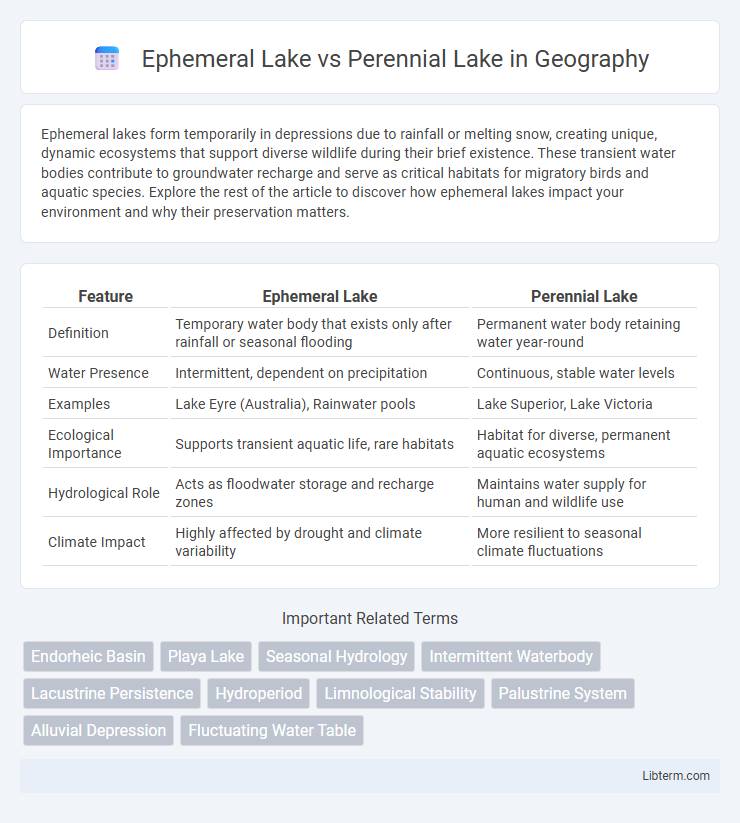Ephemeral lakes form temporarily in depressions due to rainfall or melting snow, creating unique, dynamic ecosystems that support diverse wildlife during their brief existence. These transient water bodies contribute to groundwater recharge and serve as critical habitats for migratory birds and aquatic species. Explore the rest of the article to discover how ephemeral lakes impact your environment and why their preservation matters.
Table of Comparison
| Feature | Ephemeral Lake | Perennial Lake |
|---|---|---|
| Definition | Temporary water body that exists only after rainfall or seasonal flooding | Permanent water body retaining water year-round |
| Water Presence | Intermittent, dependent on precipitation | Continuous, stable water levels |
| Examples | Lake Eyre (Australia), Rainwater pools | Lake Superior, Lake Victoria |
| Ecological Importance | Supports transient aquatic life, rare habitats | Habitat for diverse, permanent aquatic ecosystems |
| Hydrological Role | Acts as floodwater storage and recharge zones | Maintains water supply for human and wildlife use |
| Climate Impact | Highly affected by drought and climate variability | More resilient to seasonal climate fluctuations |
Introduction to Ephemeral and Perennial Lakes
Ephemeral lakes are temporary bodies of water that appear after precipitation or seasonal flooding, often drying up during dry periods. Perennial lakes, in contrast, maintain a continuous presence of water throughout the year, supported by consistent inflows such as rivers, groundwater, or rainfall. The distinction between ephemeral and perennial lakes impacts local ecosystems, water availability, and habitat stability.
Defining Ephemeral Lakes
Ephemeral lakes are temporary bodies of water that form after precipitation or flooding events and dry up seasonally, unlike perennial lakes that maintain water year-round. These lakes often occur in arid or semi-arid regions, relying on intermittent rainfall or runoff to sustain their water levels. Their fluctuating presence creates unique ecosystems adapted to periodic wet and dry cycles, influencing local biodiversity and hydrological patterns.
Defining Perennial Lakes
Perennial lakes maintain water throughout the year due to continuous inflow from rivers, groundwater, or precipitation, ensuring stable aquatic ecosystems and consistent water levels. These lakes support diverse flora and fauna because of their permanent water presence. In contrast, ephemeral lakes only contain water temporarily, often drying up during dry seasons or droughts.
Key Differences Between Ephemeral and Perennial Lakes
Ephemeral lakes exist temporarily, filling with water only after precipitation or snowmelt, while perennial lakes maintain water all year round due to consistent inflows and lower evaporation rates. Ephemeral lakes often have variable salinity and support specialized ecosystems adapted to fluctuating water levels, whereas perennial lakes provide stable habitats with diverse aquatic species. The key differences lie in their hydrological permanence, ecological stability, and water chemistry dynamics.
Hydrological Cycles and Water Sources
Ephemeral lakes rely primarily on intermittent sources such as rainfall, surface runoff, or seasonal streams, resulting in water presence only during specific periods of the hydrological cycle. Perennial lakes maintain a stable water level year-round due to continuous inputs from groundwater, springs, or consistent inflow from rivers and streams. The distinct hydrological cycles influence water availability, ecosystem diversity, and sedimentation patterns in ephemeral versus perennial lakes.
Ecological Significance of Ephemeral Lakes
Ephemeral lakes play a critical role in sustaining biodiversity by providing temporary habitats for a wide range of aquatic and terrestrial species adapted to fluctuating water levels. These lakes contribute to nutrient cycling and water purification during wet phases, supporting unique ecological processes that perennial lakes may not offer. Their periodic drying also promotes seed germination and controls invasive species, enhancing the resilience and diversity of surrounding ecosystems.
Ecological Importance of Perennial Lakes
Perennial lakes provide stable aquatic habitats that support diverse ecosystems by maintaining consistent water levels throughout the year, enabling continuous biological productivity and species survival. These lakes act as crucial refuges for migratory birds, fish, and amphibians, contributing to regional biodiversity and ecological resilience. Their sustained water presence also aids in nutrient cycling, groundwater recharge, and climate regulation, underscoring their vital ecological importance compared to ephemeral lakes.
Adaptations of Flora and Fauna in Both Lake Types
Flora and fauna in ephemeral lakes exhibit rapid growth and reproductive cycles adapted to fluctuating water availability, with species such as desert-adapted algae and amphibians that survive dry periods through dormancy or drought-resistant eggs. In contrast, perennial lake ecosystems support stable populations of aquatic plants like submerged macrophytes and fish species adapted to constant water conditions, relying on steady nutrient cycles and oxygen levels. Both environments foster unique adaptations, with ephemeral lake species emphasizing survival during dry phases and perennial lake species optimizing continuous resource use.
Human Impacts on Ephemeral and Perennial Lakes
Human impacts on ephemeral lakes often include increased water diversion and land development, which disrupt their natural flood cycles and reduce habitat availability for endemic species. Perennial lakes face challenges such as pollution from agricultural runoff, urbanization, and invasive species introduction, leading to water quality degradation and altered aquatic ecosystems. Both lake types suffer from climate change effects, including altered precipitation patterns and temperature fluctuations, intensifying stress on their hydrological and ecological balance.
Conservation Strategies for Lake Ecosystems
Ephemeral lakes, which fill and dry seasonally, require conservation strategies that prioritize maintaining natural hydrological cycles and protecting surrounding wetlands to support biodiversity during dry periods. Perennial lakes depend on sustained water inflows, so conservation efforts should focus on regulating water withdrawals, controlling pollution sources, and preserving catchment areas to ensure water quality and habitat stability. Both lake types benefit from community-based monitoring programs and adaptive management plans tailored to their unique ecological dynamics and climate variability.
Ephemeral Lake Infographic

 libterm.com
libterm.com